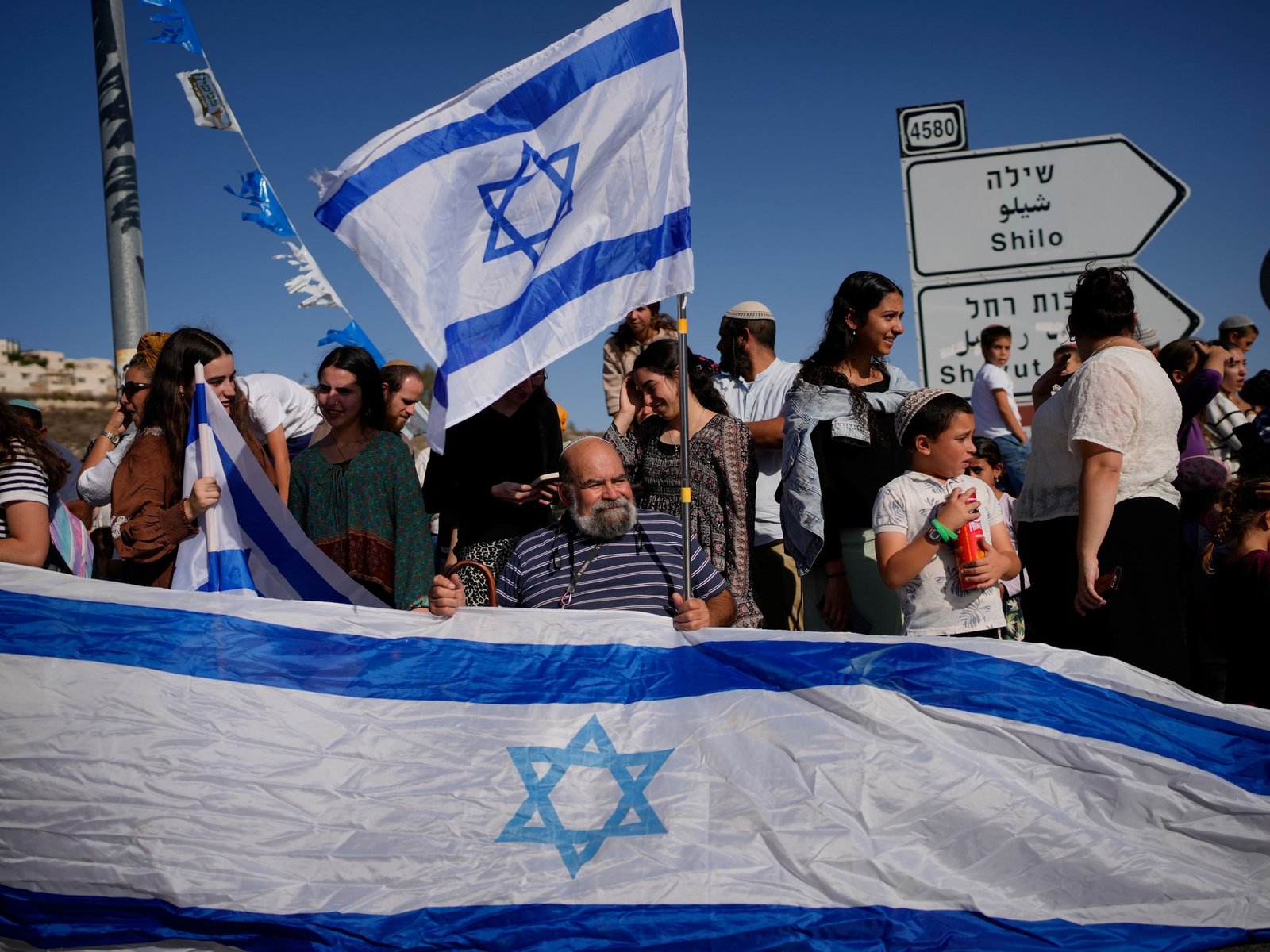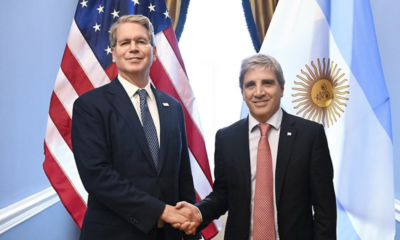INTERNACIONAL
A full breakdown of Operation Midnight Hammer, the ‘largest B-2 operational strike in US history’
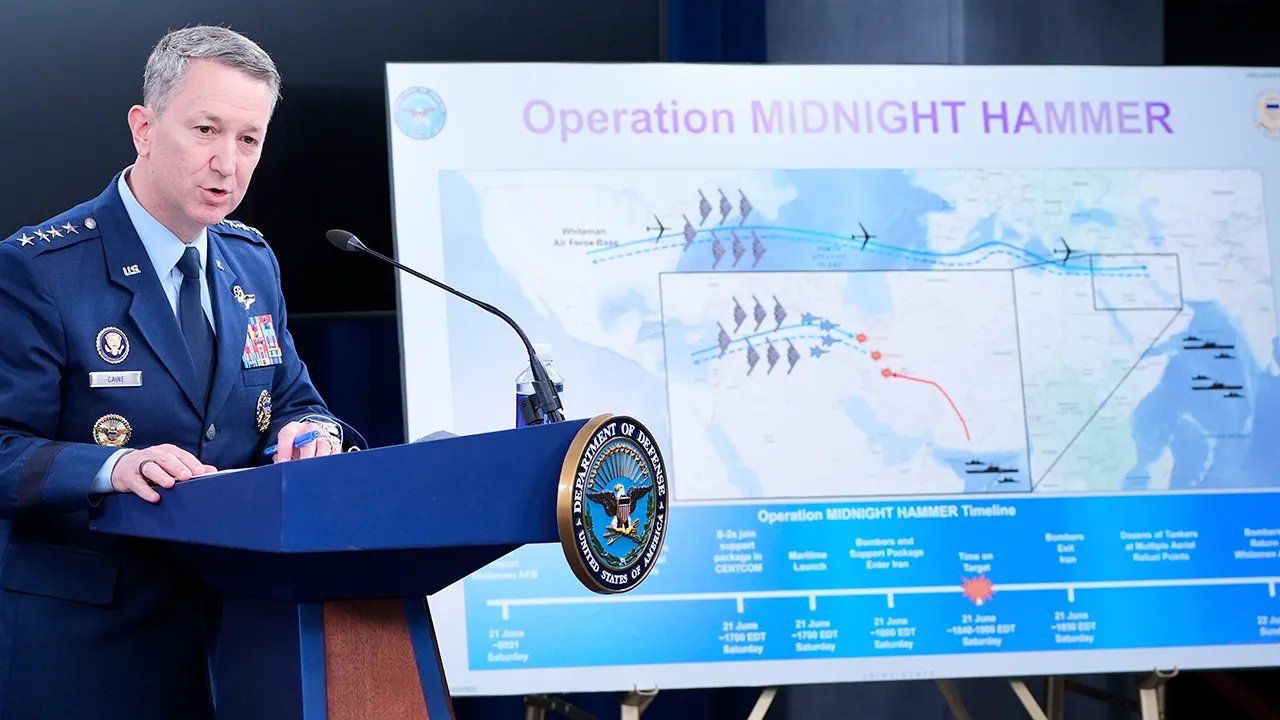
NEWYou can now listen to Fox News articles!
The Pentagon on Sunday shared details about Operation Midnight Hammer, the massive, complicated mission that struck three key Iranian nuclear facilities on Saturday, calling it the «largest B-2 operational strike in U.S. history.»
Secretary of Defense Pete Hegseth told reporters at the Pentagon that «the scope of this was intentionally limited» in his first formal remarks following the strikes, though he added that the capabilities of the American military «are nearly unlimited.»
Gen. Dan Caine, chairman of the Joint Chiefs of Staff, detailed the operation’s timeline and the deception tactics employed that went into striking Iran’s Fordow, Natanz and Isfahan nuclear facilities.
The ‘Ruse’ – Decoy flight departs at 12:01 a.m. EST, Saturday
The Pentagon shared this graphic showing the timeline of the U.S. military’s Operation Midnight Hammer. (Pentagon)
The operation commenced when B-2 stealth bombers launched from Whiteman Air Force Base in Missouri at 12:01 a.m. Saturday morning.
Some of the bombers flew to the west and into the Pacific as a decoy. Caine called it a «deception effort known only to an extremely small number of planners and key leaders.»
HEGSETH, MILITARY BRASS DESCRIBE ‘INCREDIBLE AND OVERWHELMING SUCCESS’ OF US STRIKES ON IRAN
Main strike – An 18-hour flight
The main strike force of seven B-2 Spirit bombers, each with two crew members, flew silently eastward with minimal communications as it undertook the 18-hour flight to the target area, Caine said.
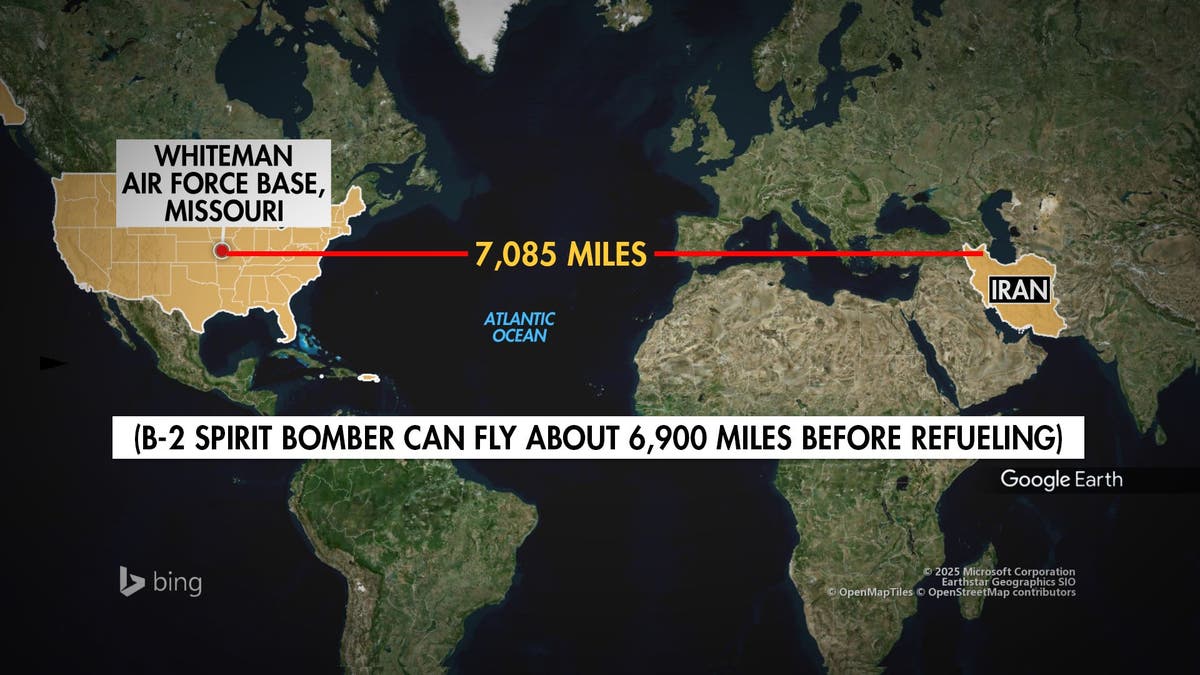
A map shows the distance from Whiteman AFB to Iran. (Fox News)
The aircraft in the group were refueled multiple times while in flight. When overland, the strike group linked up with escort and support aircraft from Central Command.
Caine described the link-up as «a complex, tightly timed maneuver requiring exact synchronization across multiple platforms in a narrow piece of airspace, all done with minimal communications.»
Clearing the way – 5 p.m. EST, Saturday
Around 5 p.m. ET (12:30 a.m. in Iran), a U.S. submarine launched more than two dozen Tomahawk land attack cruise missiles against key surface infrastructure targets as the main strike force entered Iranian airspace.
More deception tactics were used, Caine said, and support aircraft pushed out in front of the main strike group at a high altitude and speed to sweep for enemy fighters and surface-to-air missile threats.
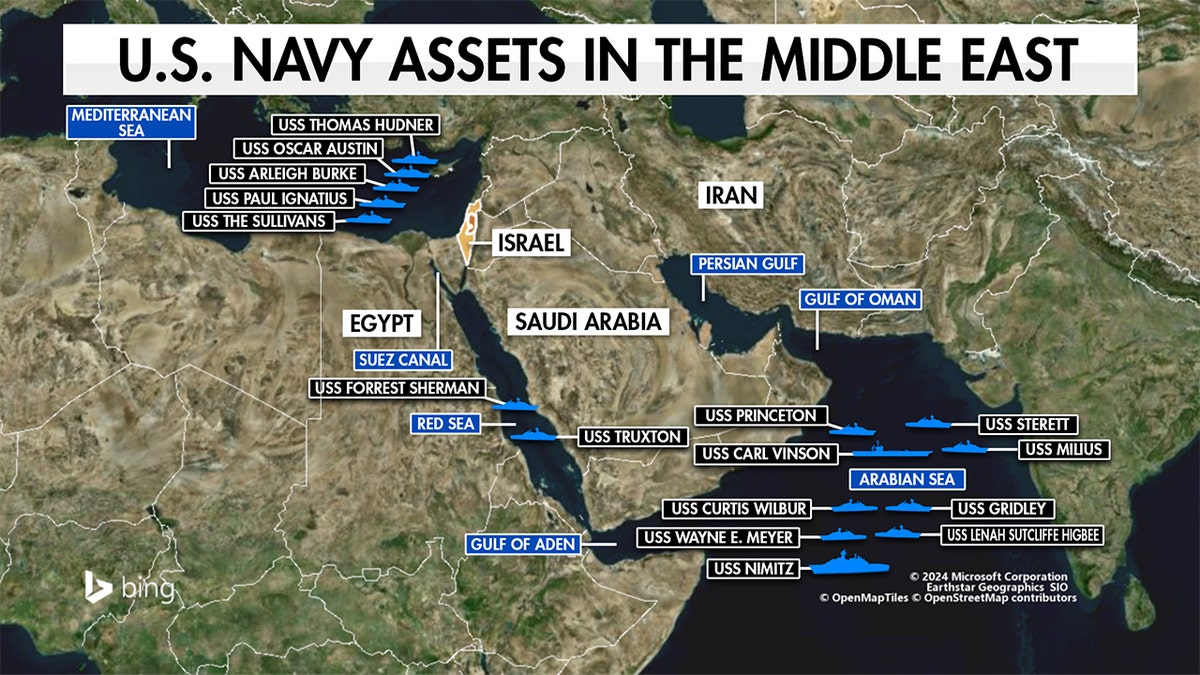
This graphic shows U.S. Navy assets in the Middle East. (Fox News)
As the B-2 main strike group approached Fordow and Natanz, support aircraft used high-speed suppression weapons to ensure its safe passage.
«We are currently unaware of any shots fired at the U.S. strike package on the way in,» Caine told reporters.
The Strikes – 6:40 p.m. EST, Saturday
The Fordow nuclear facility was struck at around 6:40 p.m. EST, or about 2:10 a.m. in Iran.
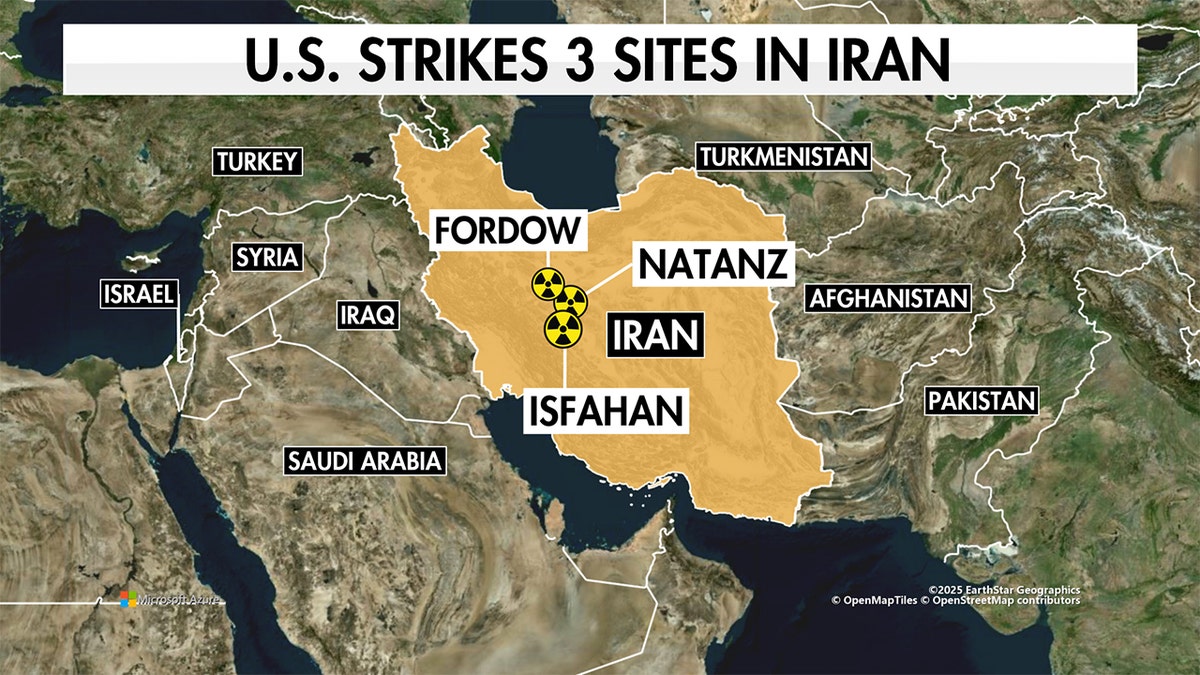
The U.S. launched strikes three key nuclear sites in Iran on Saturday night. (Fox News)
The lead B-2 dropped two GBU 57 Massive Ordnance Penetrator (MOP) weapons, commonly known as bunker-busters, on the first of several aim points at Fordow.
The remaining bombers also hit their targets, with a total of 14 MOPs dropped on Fordow and Natanz, Caine said.
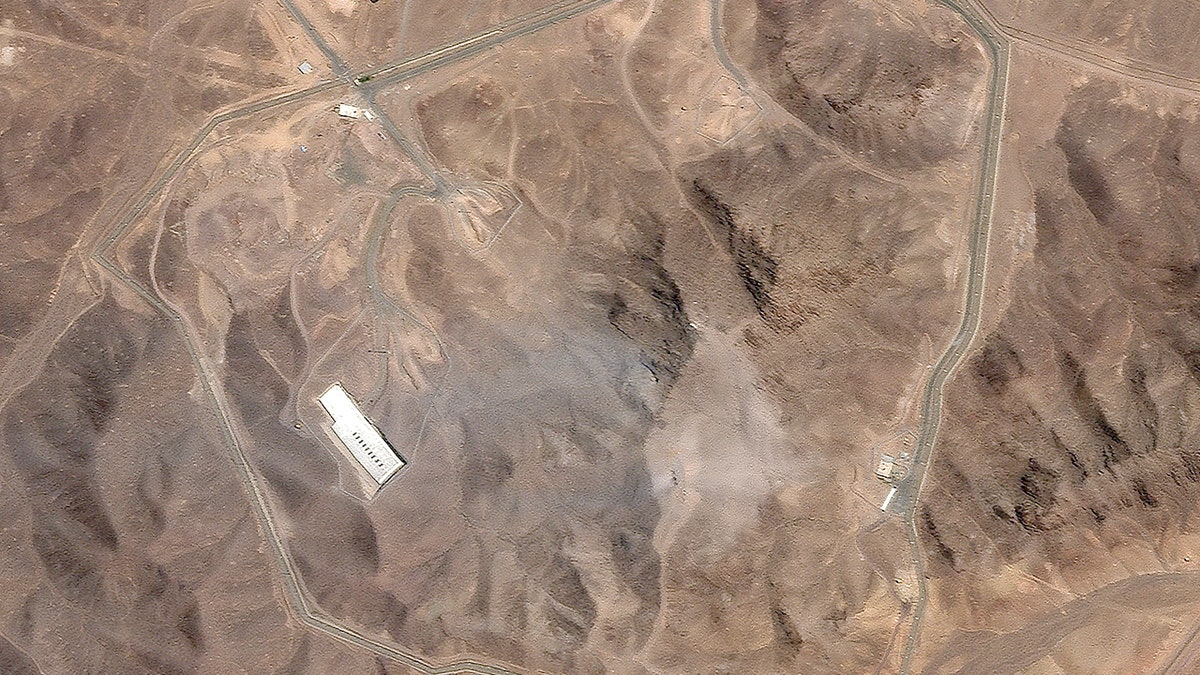
This satellite picture by Planet Labs PBC shows Iran’s underground nuclear enrichment site at Fordo after a U.S. airstrike targeted the facility on Sunday, June 22, 2025. (Planet Labs PBC via AP)
The Tomahawk missiles launched by U.S. submarines were the last to strike, hitting their targets at Isfahan.
The return journey – Saturday to Sunday
After releasing their weapons in the massive strike, the aircraft exited Iranian airspace to return home to Whiteman Air Force Base. Caine said the U.S. military was not immediately aware of any shots being fired at the strike group on its way out of Iranian airspace.
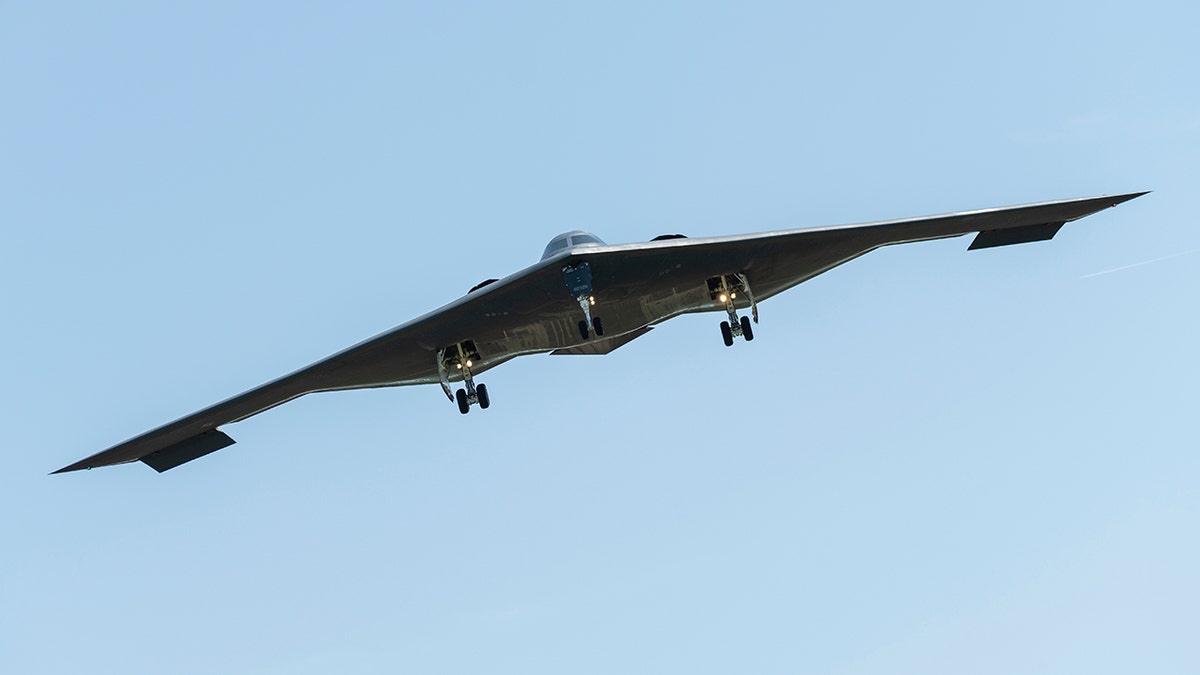
In this image provided by the U.S. Air Force, a B-2 Spirit returns to Whiteman Air Force Base, Mo., on May 9, 2025. Seven B-2 aircraft were used in Operation Midnight Hammer, Caine said Sunday. (Senior Airman Devan Halstead/U.S. Air Force via AP)
«Iran’s fighters did not fly, and it appears that Iran’s surface-to-air missile systems did not see us throughout the mission,» Caine said. «We retained the element of surprise.»
TRUMP ADDRESSES NATION ON ‘SPECTACULAR MILITARY SUCCESS’ OF US STRIKES ON IRANIAN NUCLEAR FACILITIES
Operation Midnight Hammer used more than 125 aircraft in the mission, including seven B-2 stealth bombers, multiple fourth and fifth generation fighters, dozens of air refueling tankers, a guided missile submarine and «a full array» of intelligence, surveillance, and reconnaissance aircraft, Caine said.
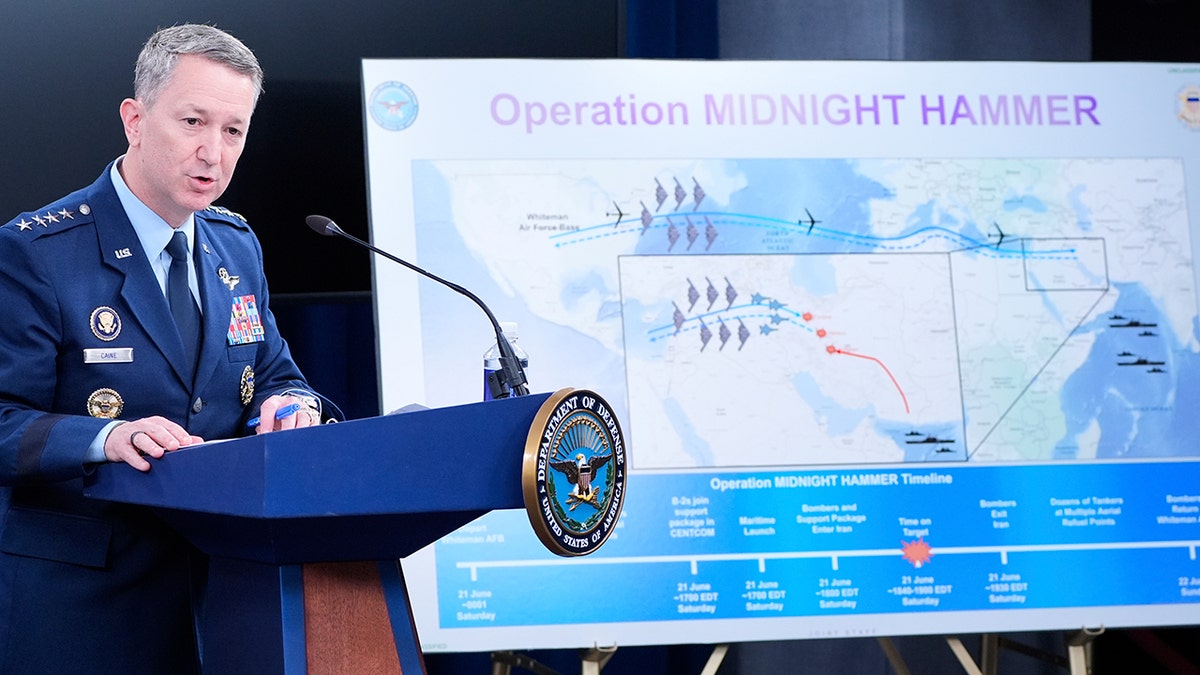
Joint Chiefs Chairman Gen. Dan Caine shared the Operation Midnight Timeline during a news conference at the Pentagon in Washington, Sunday, June 22, 2025, after the U.S. military struck three sites in Iran. (AP Photo/Alex Brandon)
U.S. forces launched approximately 75 precision-guided munitions, including 14 GBU 57 massive Ordnance penetrators, which weigh 30,000 pounds each. The operation marked the first-ever operational use of this weapon, Caine said.
A history-making operation
Caine called the operation the «largest B-2 operational strike in U.S. history,» and that «no other military in the world could have done this.»
«This mission demonstrates the unmatched reach, coordination and capability of the United States military in just a matter of weeks,» Caine said. «This went from strategic planning to global execution.»
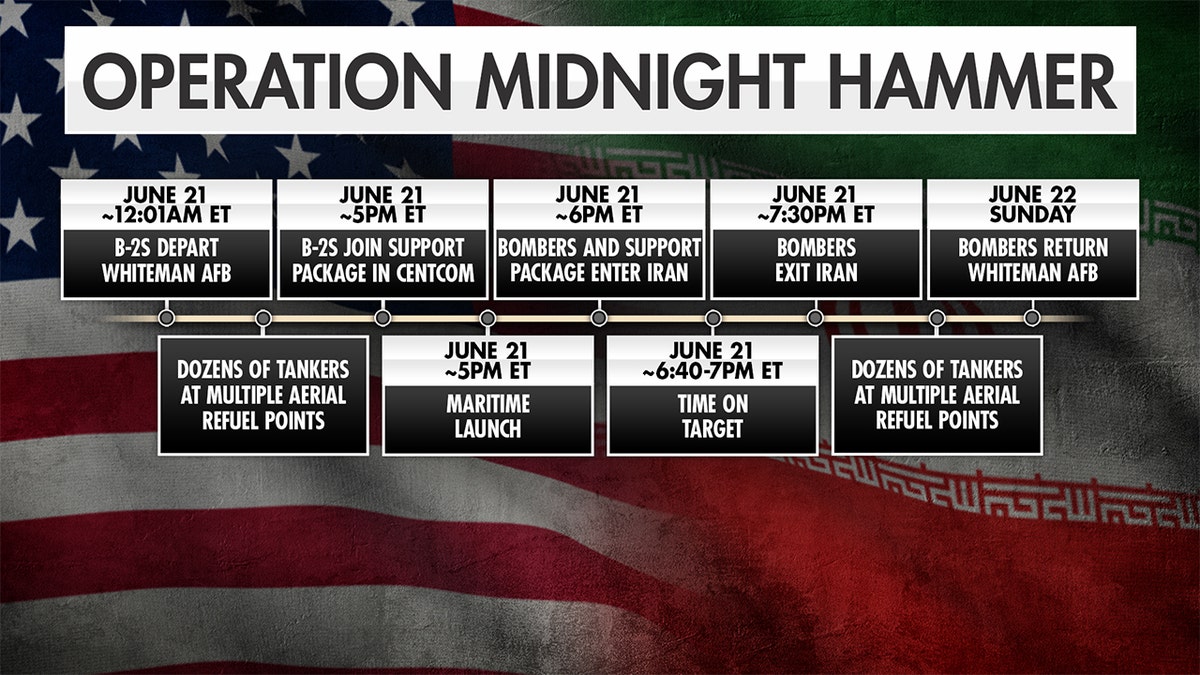
A timeline shows the approximate timeline of US strikes against Iranian nuclear targets on June 22, 2025. (Fox News)
CLICK HERE TO GET THE FOX NEWS APP
Caine also said this was the second-longest B-2 mission ever flown, exceeded only by missions flown in the days following 9/11.
INTERNACIONAL
Brasil subastó cinco nuevos bloques petroleros en el Atlántico, a pocos días de la cumbre climática COP30
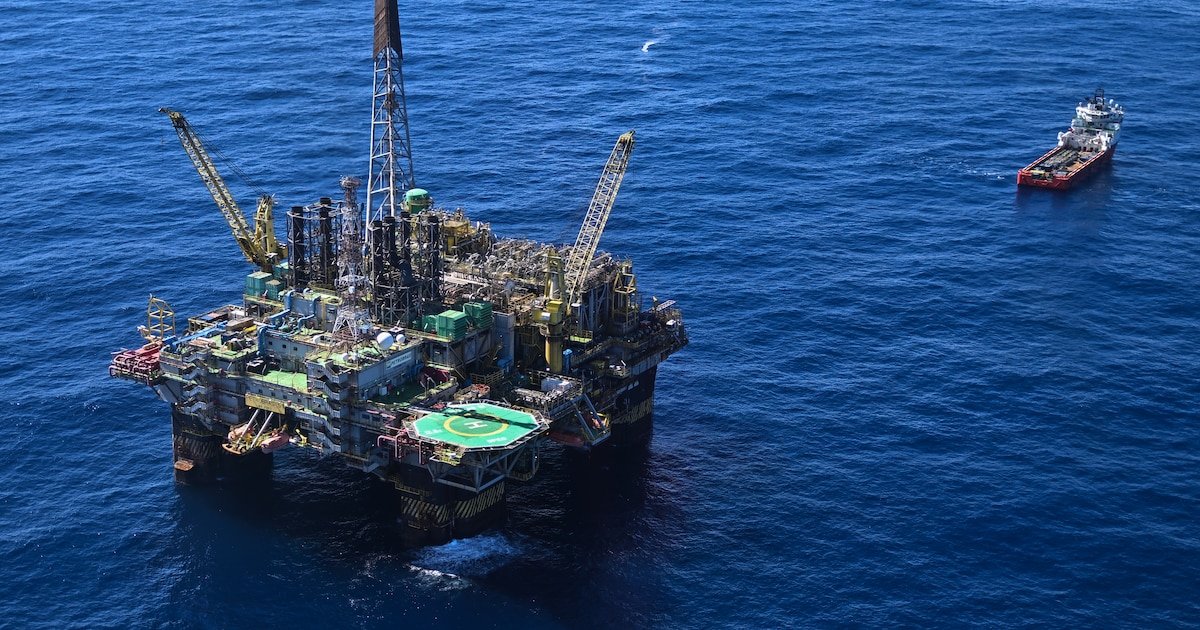
El gobierno de Brasil otorgó este miércoles los derechos de exploración de cinco bloques petroleros situados en aguas profundas del Atlántico, apenas dos días después de que la estatal Petrobras obtuviera licencia ambiental para iniciar perforaciones exploratorias marítimas cerca de la desembocadura del río Amazonas. La decisión reafirma el compromiso brasileño con la producción petrolera, una postura que genera controversia a menos de un mes de la conferencia climática COP30 de la ONU en la ciudad amazónica de Belém.
Las subastas, organizadas por la Agencia Nacional del Petróleo (ANP), se llevaron a cabo en Río de Janeiro y sumaron un total de 103,7 millones de reales (alrededor de 19,2 millones de dólares). De los siete bloques ofertados, cinco fueron adjudicados a grandes consorcios internacionales y nacionales, entre ellos la multinacional noruega Equinor y la china Cnooc. Estas áreas se localizan en el denominado presal, una reserva petrolera ubicada bajo una gruesa capa de sal en aguas ultraprofundas, donde se estima la existencia de yacimientos de alto potencial económico.
De las siete zonas ofrecidas en la subasta, las áreas de Jaspe, Citrino e Itaimbezinho fueron obtenidas respectivamente por un consorcio integrado por Petrobras (60%) y Equinor (40%), por Petrobras de forma individual, y por Equinor también de manera individual. Todas ellas se encuentran en la cuenca de Campos, frente al litoral del estado de Río de Janeiro.
En la cuenca de Santos, frente a las costas de San Pablo, la australiana Karoon se adjudicó el bloque de Esmeralda, mientras que un consorcio liderado por CNOOC (70%) y Sinopec (30%) obtuvo el área de Amatista. El resto de los bloques ofertados no atrajo el interés de las 15 empresas habilitadas para participar.
A diferencia de anteriores licitaciones, en esta ocasión no se otorgaron concesiones plenas, sino que las empresas ganadoras operarán en asociación con el Estado brasileño, que mantiene la propiedad de los derechos de exploración y producción. Para resultar seleccionadas, las compañías debieron ofrecer el mayor porcentaje de participación estatal en el excedente de producción de petróleo y gas.

La subasta formaba parte de una oferta inicial de 13 áreas, aunque las compañías solo mostraron interés por siete. De acuerdo con Artur Watt, director general de la ANP, “el mantenimiento de las actividades de exploración y producción es completamente compatible con la transición energética”. Watt defendió que este proceso debe acelerarse ajustando la demanda, sin restringir voluntariamente el suministro nacional, dado que “sería rápidamente cubierto por otros países en detrimento de los intereses nacionales”.
El lunes, Petrobras recibió la licencia ambiental del Instituto Brasileño del Medio Ambiente y de los Recursos Naturales Renovables (Ibama) para perforar un pozo exploratorio en el bloque FZA-M-059, situado a 175 kilómetros de la costa del estado de Amapá, próximo a la frontera con Surinam. La estatal inició los trabajos el mismo día de la autorización, según informó en un comunicado. Este pozo no producirá petróleo durante la fase exploratoria y las tareas podrían extenderse hasta cinco meses.
El ministro de Energía, Alexandre Silveira, celebró la decisión y subrayó en sus redes sociales que “el Margen Ecuatorial representa el futuro de nuestra soberanía energética. Brasil no puede renunciar a conocer su potencial”. Silveira insistió en que la perforación se realizará bajo “los más altos estándares internacionales” y con “responsabilidad ambiental”.
No obstante, la explotación petrolera en la región ha suscitado críticas de organizaciones ambientalistas y comunidades indígenas, dadas la vulnerabilidad y “extrema sensibilidad” del ecosistema amazónico. La polémica aumenta en vísperas de la COP30, donde uno de los ejes clave de debate será la reducción gradual del uso de combustibles fósiles.
La Margen Ecuatorial, que se extiende desde la frontera con Surinam hasta el noreste del país, es señalada por analistas geológicos y la industria como una de las zonas más prometedoras de Brasil por sus similitudes con los descubrimientos de hidrocarburos realizados en Guyana. Durante la última década, la región ha sido objeto de exploración por parte de importantes compañías internacionales, como Chevron, ExxonMobil, Petrobras y la Corporación Nacional de Petróleo de China.
El gobierno de Lula da Silva argumenta que el crecimiento del sector es clave para financiar la transición energética y el desarrollo económico. En junio, el Ejecutivo subastó otros 19 bloques en alta mar, algunos en cercanías del Amazonas, reafirmando su determinación de expandir la actividad petrolera en el país pese a las restricciones impuestas por las demandas ambientales.
La exploración en aguas profundas bajo la capa de sal, así como en la denominada Margen Ecuatorial, plantea desafíos técnicos y ambientales, en especial por las fuertes corrientes oceánicas y la proximidad a zonas de alta biodiversidad. Petrobras señaló que el pozo exploratorio en el bloque FZA-M-059 forma parte de su estrategia para incrementar reservas y conocer el potencial petrolero brasileño, aunque aún no está previsto su desarrollo comercial inmediato.
(Con información de AFP, AP y EFE)
cuenca de campos,empresas,empresas petroleras brasileñas,exterior,petrobras,petrolíferas,plantas,plataforma p-51,plataformas de petróleo,semi-públicas
INTERNACIONAL
Trump to host roundtable on efforts to thwart cartels, human trafficking operations
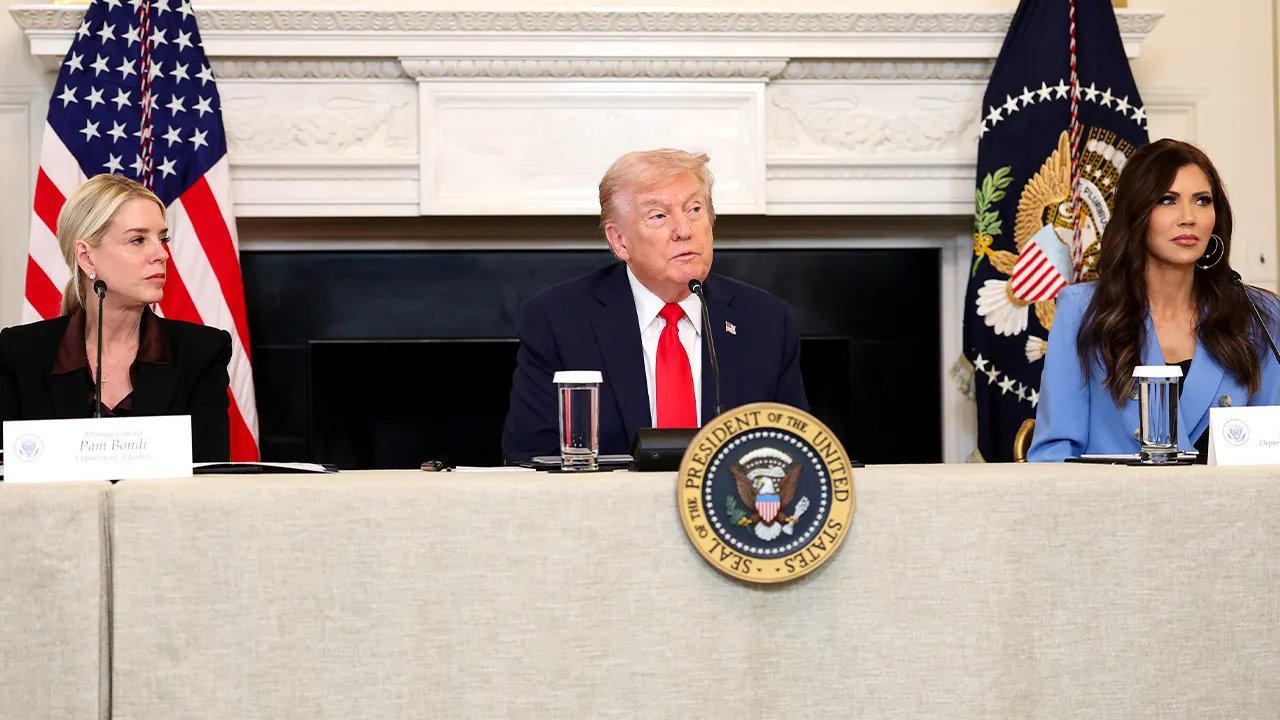
Mexican leaders want US help against cartels
Mexican Senator Lilly Téllez joins ‘Fox & Friends Weekend’ to discuss growing tensions between President Trump and Venezuelan leader Nicolás Maduro as the U.S. boosts its military presence in the region to target drug boats and cartels.
NEWYou can now listen to Fox News articles!
FIRST ON FOX: President Donald Trump will host a roundtable at the White House Thursday afternoon with law enforcement and administration officials to discuss the successes of the Homeland Security Task Forces, which the president established on his first day in office to snuff out threats from criminal cartels in the U.S.
«The President’s Homeland Security Task Forces are a landmark achievement that highlight what the federal government can achieve with a leader like President Trump who is willing to slash red tape, increase coordination and put the safety of the American people first,» White House spokeswoman Abigail Jackson told Fox News Digital of the event.
«In a short period of time, the Trump Administration has removed lethal drugs, illegal weapons, dangerous foreign terrorists and cartel members from American communities,» she added. «The American people are safer today because of the HSTFs — and they’re just getting started.»
Trump established the creation of Homeland Security Task Forces Jan. 20 — his first day back in office — via executive order, «Protecting the American People from Invasion.» The executive order directed Attorney General Pam Bondi and Secretary of Homeland Security Kristi Noem to establish such task forces in each state as part of the administration’s efforts to thwart cartels and human trafficking networks operating on U.S. soil.
WAR DEPARTMENT LAUNCHES NEW COUNTER-NARCOTICS TASK FORCE UNDER TRUMP DIRECTIVE TO CRUSH CARTELS
President Donald Trump is slated to hold a roundtable with administration officials to discuss updates on the Homeland Security Task Forces. ( Anna Moneymaker/Getty Images)
The executive order specifically directed the task forces to «end the presence of criminal cartels, foreign gangs, and transnational criminal organizations throughout the United States, dismantle cross-border human smuggling and trafficking networks, end the scourge of human smuggling and trafficking, with a particular focus on such offenses involving children, and ensure the use of all available law enforcement tools to faithfully execute the immigration laws of the United States.»
On Thursday, administration officials will join Trump to provide updates on the task forces’ efforts.
The roundtable will be joined by Deputy Chief of Staff and Homeland Security Advisor Stephen Miller, Noem, Bondi, Deputy Attorney General Todd Blanche, Secretary of War Pete Hegseth, FBI Director Kash Patel and Director of National Intelligence Tulsi Gabbard, Fox News Digital learned.
TRUMP SENDS MILITARY AFTER THE CARTELS AND IT’S LONG OVERDUE
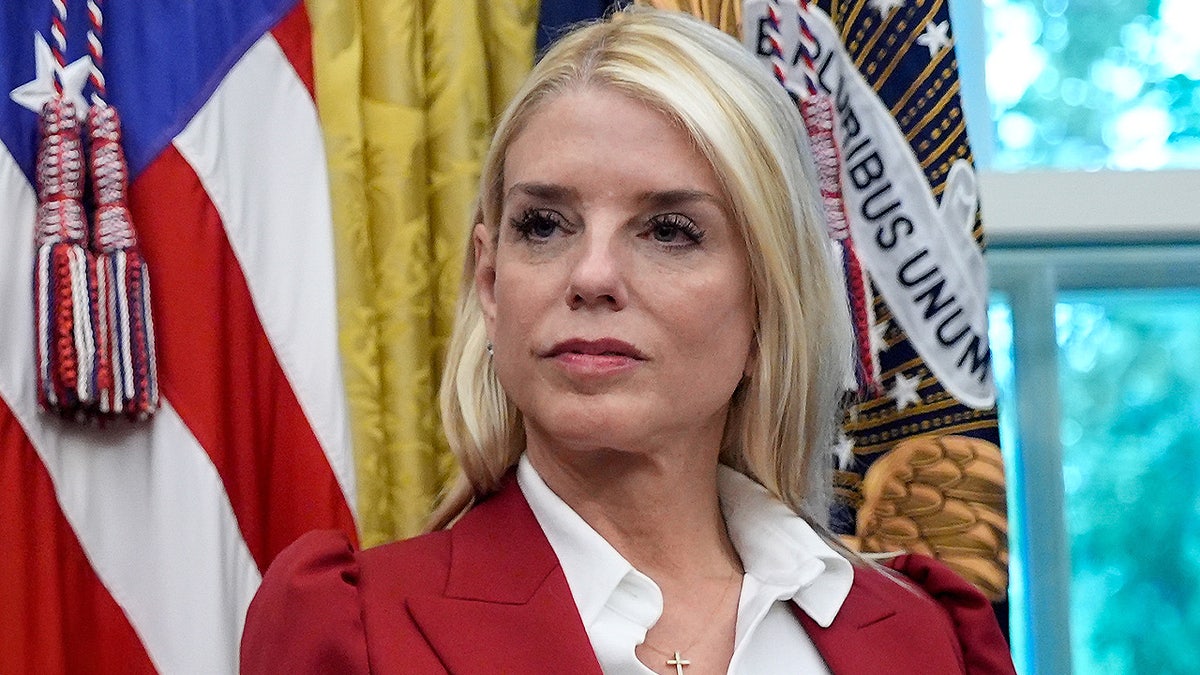
A January executive order directed Attorney General Pam Bondi, here, and Secretary of Homeland Security Kristi Noem to establish such task forces in each state as part of the administration’s efforts to thwart cartels and human trafficking networks operating on U.S. soil. (Yuri Gripas/Abaca/Bloomberg via Getty Images)
Fox News Digital learned that the task forces nationwide became fully operational at the end of August and have yielded thousands of arrests, and the removal of dangerous drugs and illegal firearms from U.S. streets.
BONDI SAYS HUMAN SMUGGLING IS ‘GETTING PEOPLE KILLED’ ACROSS US AS SHE ANNOUNCES CRACKDOWN
More than 3,000 foreign terrorists and cartel members were arrested as part of the task forces’ operations, including members of notoriously dangerous gangs such as the Sinaloa Cartel, MS-13 and Cartel Jalisco Nuevo Genaracion, Fox News Digital learned.
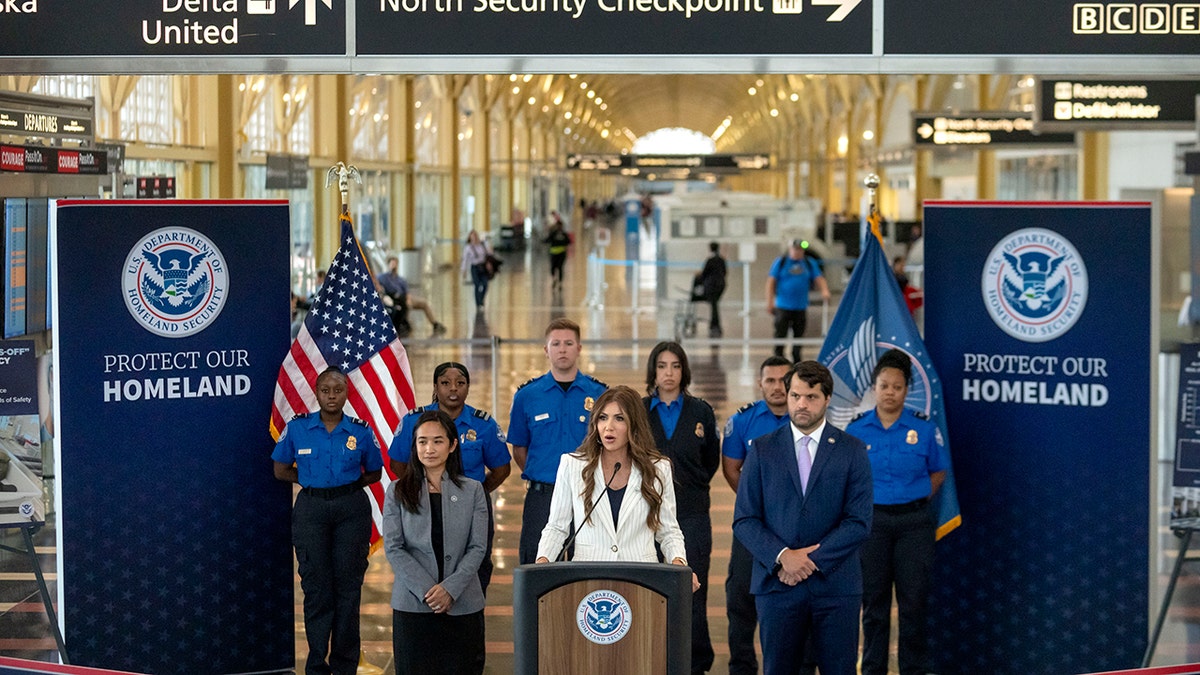
President Donald Trump will host a roundtable at the White House Oct. 23, 2025, with law enforcement and administration officials, like Homeland Security Secretary Kristi Noem. (Mark Schiefelbein/The Associated Press)
The task forces also have recovered two million fentanyl pills and seven tons of other deadly narcotics, seized $3 million in currency and removed more than 1,000 illegal guns from U.S. communities.
Trump campaigned, in part, on removing violent illegal immigrants and crime from U.S. communities, spotlighting the efforts in his address before Congress back in March 2025.
«The territory to the immediate south of our border is now dominated entirely by criminal cartels that murder, rape, torture and exercise total control. They have total control over a whole nation. posing a grave threat to our national security,» Trump said at the time. «The cartels are waging war in America, and it’s time for America to wage war on the cartels.»
The roundtable comes as the U.S. military carries out strikes on suspected drug cartel vessels in the Caribbean and eastern Pacific. The strikes began in September and are part of Trump’s broader effort to dismantle transnational cartels by force.
CLICK HERE TO GET THE FOX NEWS APP
Trump held a similar roundtable at the White House earlier in October, inviting independent journalists who have experienced Antifa’s violence firsthand to speak about their experiences as the administration targets the left-wing group’s protests outside immigration facilities and recently designating it a «domestic terrorist organization.»
donald trump,white house,border security,homeland security,immigration
INTERNACIONAL
Quiénes son los 13 rehenes muertos que Hamas todavía no entregó a Israel

 DEPORTE20 horas ago
DEPORTE20 horas agoUniversidad de Chile vs. Lanús, por la Copa Sudamericana: día, horario y cómo verlo por TV

 CHIMENTOS3 días ago
CHIMENTOS3 días agoLa conductora y el periodista de C5N que festejaron el día de la madre anunciado su embarazo: «Mejor que dos son tres»

 ECONOMIA2 días ago
ECONOMIA2 días agoScott Bessent oficializó el swap con la Argentina y afirmó: “No queremos otro Estado fallido en América Latina”

